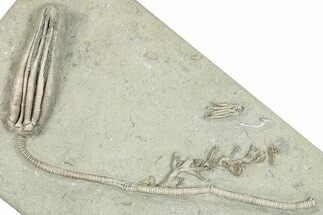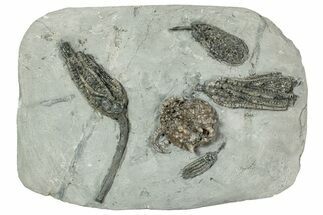This Specimen has been sold.
Beautiful 1.7" Macrocrinus Mundulus Crinoid
This is a beautifully preserved Macrocrinus mundulus crinoid fossil from Montgomery County, Indiana. The crown is 1.15" long and it's 1.7" including the stem. The light tan color of the shell contrasts well against the light grey mudstone. It has been prepared and identified by one of more most world renown fossil preparators who's done a lot of work on the Crawfordsville, Crinoids.
Crinoids are commonly known as sea lilies, though they are animals, not plants. They are echinoderms related to starfish, sea urchins, and brittle stars. They attached themselves to the sea floor and had feathery, tentacle-like appendages which they used to capture particles of food. First appearing in the Ordovician period, 488 million years ago, they still survive to this day in deep water.
Crinoids are commonly known as sea lilies, though they are animals, not plants. They are echinoderms related to starfish, sea urchins, and brittle stars. They attached themselves to the sea floor and had feathery, tentacle-like appendages which they used to capture particles of food. First appearing in the Ordovician period, 488 million years ago, they still survive to this day in deep water.
SPECIES
Macrocrinus mundulus
LOCATION
Montgomery County, Indiana
FORMATION
Ramp Creek Limestone
SIZE
Crinoid 1.7" long, Crown 1.15"
CATEGORY
SUB CATEGORY
ITEM
#8336
We guarantee the authenticity of all of our specimens.
 Reviews
Reviews












